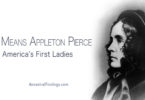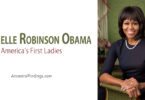Wife of ninth U.S. president William Henry Harrison, Anna Tuthill Symmes Harrison was the First Lady with a list of interesting distinctions. First of all, she was First Lady to the shortest-serving U.S. president, as her husband only served about a month of his term before dying of a malady he caught while giving his record-breaking long inauguration speech outside in the rain, in winter. Second, at age 65 when her husband took office, she is the oldest woman to ever become First Lady for the first time. Third, she was the first First Lady to become widowed while in the White House. And, fourth, she was the last First Lady to be born in the United States while it was still a British colony.
But, don’t make the mistake of thinking these interesting historical tidbits are the only things that make Anna Harrison a person worth historical study. She was quite the woman in her own right.
Anna was born into a wealthy family in New Jersey on July 25, 1775. Her parents were John Cleves Symmes (a local judge) and Anna Tuthill. John was Chief Justice of the New Jersey Supreme Court at one point, and later became a prominent landowner in Ohio.
Anna’s mother died the year following Anna’s birth, in the midst of the American Revolution. To get the baby Anna to safety, John Symmes disguised himself as a British soldier, and took Anna past enemy lines to her mother’s parents in Long Island, to care for them at their home for the war’s duration. Meanwhile, her father became intimately involved in the Revolution, as well as setting up the new country, serving as Deputy to the Provincial Congress of New Jersey, the Chairman of the Sussex County Committee of Safety, and as a New Jersey delegate to the 1785-1786 Continental Congress.
While her father was occupied with revolutionary things, Anna grew up on Long Island, receiving an exemplary education at the Clinton Academy at Easthampton, and at the Isabella Graham Private School. She was better and more broadly educated than most girls of her time, thanks to the devotion of her maternal grandparents.
Eventually, Anna’s father re-married, and after the war, when Anna was 21 years old, she moved with him and his second wife (Susannah Livingston, daughter of New Jersey governor William Livingston) to Ohio, to help settle the wilderness there for the new nation. The following year, 1795, Anna went to visit some relatives in Kentucky. It was there she met Lieutenant William Henry Harrison, who was in town on military business. The attraction between Anna and William was instant and considerable. However, Anna’s father did not approve of their courtship, as he did not want his daughter to be a military wife and subjected to the hardships of living in frontier army camps. He demanded the two stop seeing each other.
As often happens with young love, however, they did not let parental disapproval stand in their way. Anna and William continued to see each other behind her father’s back. Later that same year they met, Anna’s father went away on business, and Anna and William took the opportunity his absence offered and eloped. They honeymooned at Fort Washington because William was still on duty and stationed there. It was not until two weeks after their wedding, at a farewell dinner for General “Mad” Anthony Wayne, that John Symmes was able to confront the new couple about their secret marriage. He demanded to know how William intended to support his daughter. William replied,
“By my sword, and my own right arm, sir.”
John had no choice but to accept the marriage, as both parties were of age, but he did not like it, and he did not like William for a long time. It was not until years later when William had made a brilliant name for himself as a career military officer, including shining during the War of 1812, that John came to grudgingly respect his son-in-law.
Anna and William had ten children together nine of whom lived past childhood. However, five of those nine, though they grew up, did not outlive their parents.
While in the military, William also had a brilliant civilian career, serving in the U.S. Congress as a territorial delegate from Ohio, and as governor of Indiana. After the War of 1812, Anna hoped her husband could finally retire from both military and public life, but he had too many admirers to be left alone for long at that point. Without really trying, he found himself a candidate for U.S. president in the 1840 elections, and his popularity as a military hero gave him a landslide victory. Anna was not exactly pleased with this win. She is quoted as saying, upon hearing of his presidential victory,
“I wish that my husband’s friends had left him where he is, happy and contented in retirement.“
When William was inaugurated, Anna was ill at home, and thus did not go with him to Washington, D.C. She intended to go later when she was recovered. William took his daughter-in-law, Jane Irwin Harrison, widow of his late son, William Henry Harrison, Jr. with him to serve as hostess at the White House until Anna’s promised arrival in May of 1841.
Jane was not the only one to make the journey to the nation’s capital to see their relative become U.S. president. Six other relatives went with them. Anna was packing to leave to join them when word of William’s death reached her via letter, so she never went to Washington, D.C. when her husband was president. She was First Lady in name only, and had every intention of being a real one, but never got the chance. However, during William’s brief time in office, no one questioned that Anna, there or not, was the nation’s, First Lady.
After William died, Anna lived the rest of her life in Ohio with her son, John, and helped him raise his children. One of those children, Benjamin, would later become President of the United States as well, just like his grandfather. Anna died 23 years after William in 1864 at age 88 and was buried beside him at the William Henry Harrison Tomb State Memorial in their hometown of North Bend, Ohio.






